- Homepage
- News and Features
- New trends in aeration and organic matter management
New trends in aeration and organic matter management
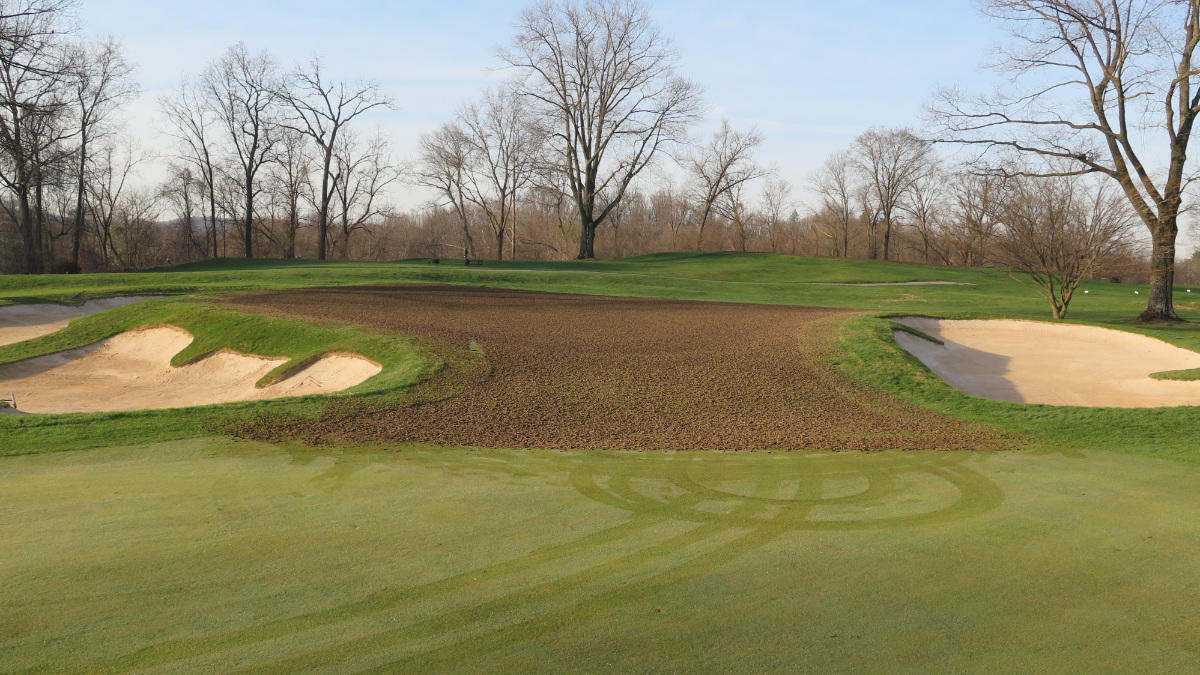
With too much organic matter, putting greens become soft and are at greater risk for disease and other forms of decline such as mechanical damage, especially during periods of unfavourable weather.
Conversely, not enough organic matter can be problematic as well. Without enough organic matter, the putting surface loses stability and becomes ‘shifty’ underfoot – typically resulting in decreased traffic tolerance. This problem is less common because it typically results from performing aggressive cultural practices at a high frequency – something most facilities try to avoid.
While most of the golf community would agree that healthy greens and firm playing conditions are preferred, there is often a great deal of contention when disruptive practices are implemented to provide these conditions. The good news is that new equipment, tools and techniques have greenkeepers better equipped to properly manage organic matter with less impact on playability.
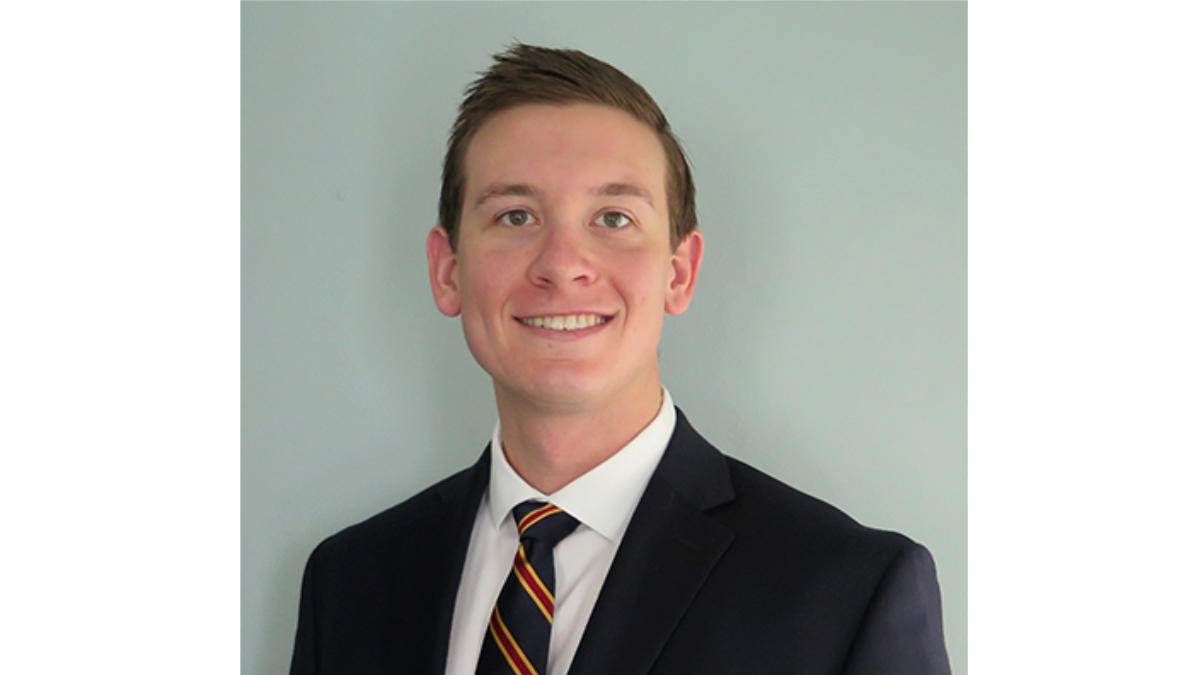
There is no one‑size‑fits‑all programme for organic matter management. It is critical to evaluate the profile of your putting greens to identify potential issues and then determine what practices would best address those needs. Organic matter management is a balancing act between the rate of accumulation and the rate of removal and dilution. Factors such as fertility, growth regulation, growing environment and turf species will influence the rate of accumulation. For this reason, it is also important to review your entire putting green management programme when developing plans for organic matter management.
Regardless of current organic matter content or putting green management programmes, some type of cultural practices will be necessary to manage organic matter. Traditionally, most courses have relied on hollow‑tine aeration twice annually with larger‑diameter tines to address their aeration needs. However, there are several new methods gaining popularity that tend to have less impact on playability.
Sand injection
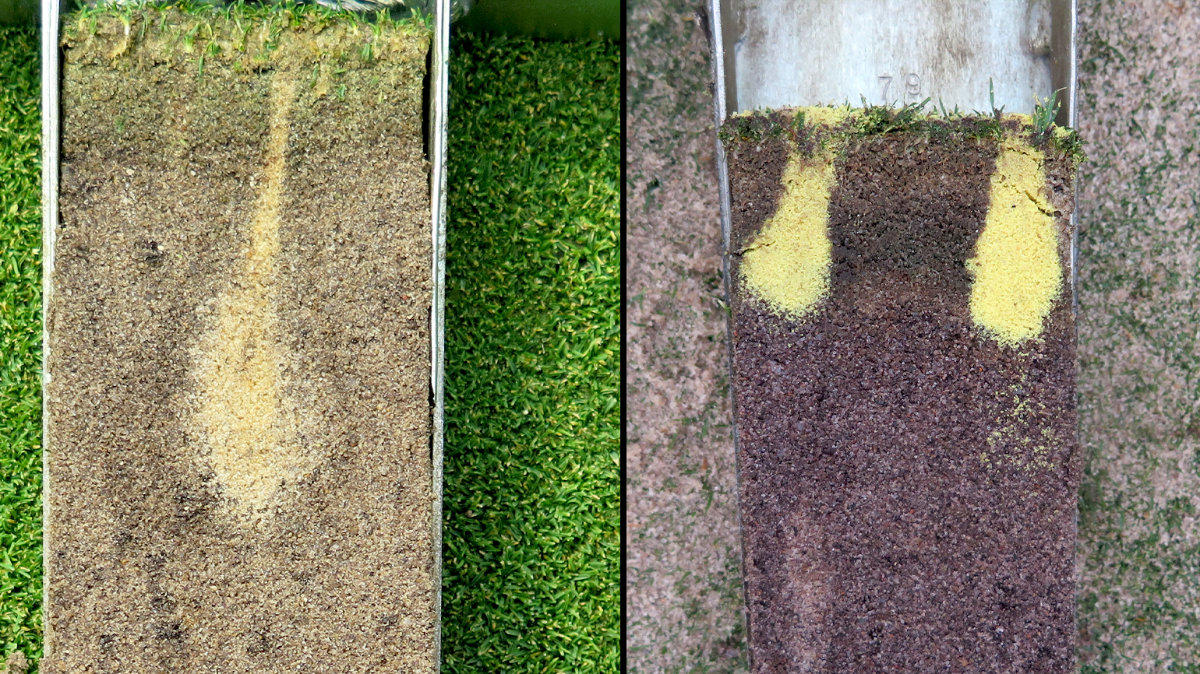
Sand injection is not necessarily a new trend or tool, but how it is being used continues to evolve. It is typically a contracted service that uses high‑pressure blasts of water to inject sand into the putting green profile. Traditionally, the injected sand would form a teardrop shape in the soil profile, leaving most of the sand injected about 3‑6 inches below the surface. This helps to improve internal drainage but is not the optimal placement of sand if diluting organic matter near the surface is your primary objective.
Recent modifications to sand injection equipment have altered how the sand is injected into the profile. Now, sand can be injected into the upper 2 inches if desired. This is a much better placement of sand if organic matter management in the upper portion of the profile is your primary objective.
Sand injection is relatively nondisruptive compared to traditional core aeration, but it does not remove any organic matter like core aeration does. That said, facilities with excessive organic matter content would see the greatest benefit by supplementing core aeration with sand injection, not replacing it. However, if organic matter content is already being managed within an ideal range, shallow sand injection has the potential to replace other forms of cultivation.
Another use for shallow sand injection is helping to alleviate the negative effects of a sod layer. Oftentimes when sod is used to establish putting greens, an organic layer comes with the sod that will inhibit downward water movement and root development, but the greens can be too delicate after sodding to perform traditional core aeration. Shallow sand injection is beneficial in this situation because it creates sand channels through the sod layer without the aggressive pulling action associated with core aeration.
Sand topdressing
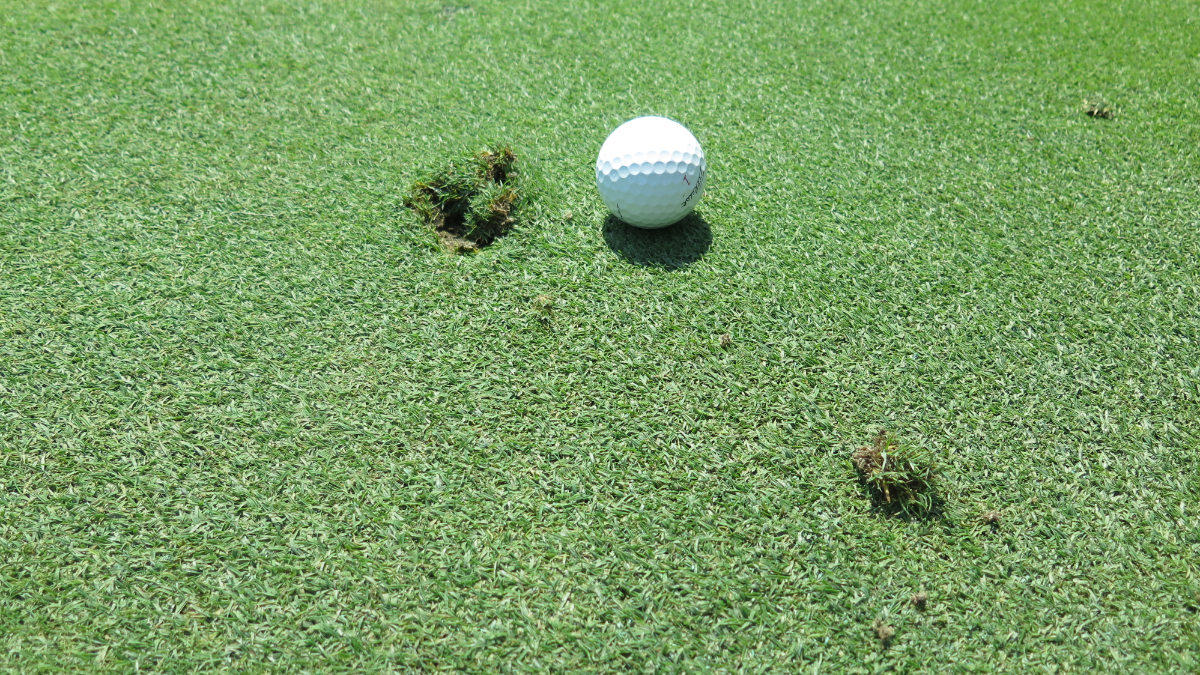
Sand topdressing is one of the most beneficial practices that can be performed on putting greens. The primary benefits of sand topdressing include:
- Organic matter dilution
- Surface smoothing
- Crown protection, resulting in decreased susceptibility to anthracnose disease on Poa annua putting greens
Despite the numerous benefits of sand topdressing, some golfers find it objectionable when sand particles remain on the surface because they impact ball roll. From a maintenance perspective, greenkeepers may elect not to topdress as often as they would like for fear of damaging mowing equipment. To overcome both issues, facilities are » adopting a two‑sand system where a less‑coarse sand is used for regular topdressing applications and a more well‑graded sand is used for aeration.
Using a less coarse sand for topdressing may sound like it would result in textural layering issues, but recent research from Rutgers University has shown that’s not necessarily the case (Murphy et al., 2019). In this ongoing research, preliminary results have shown that topdressing with a less‑coarse sand that contains 23% fine particles and 77% medium particles did not significantly increase soil moisture compared to plots topdressed with coarser material. Using a fine‑medium sand, which contained 69% fine particles, did increase soil moisture compared to plots topdressed with coarser materials, but these plots had lower soil moisture than plots that were never topdressed. However, when the plots topdressed with the fine‑medium sand were aerated and backfilled with the medium‑coarse sand, they performed more similar to plots that were topdressed with coarser materials and not aerated (Whitlark and Thompson, 2019).
That said, using a topdressing sand with predominantly fine sand particles is not ideal, but it is better than not topdressing at all. However, reducing the amount of very coarse and coarse particles in a topdressing sand allows the sand to be incorporated into the dense canopy much easier, thus reducing the impact on playability and wear on mowing equipment.
Facilities adopting the two‑sand system should use a more well‑graded sand during aeration or aggressive verticutting to incorporate larger particles into the profile. The physical properties of this sand should closely match the sand used for construction if the putting greens are sand‑based. Ensuring larger particles are being incorporated into the profile will help improve infiltration and surface firmness by maintaining a well‑graded sand composition in the topdressing layer.
‘Micro’ hollow‑tine aeration
Aerating with small‑diameter hollow tines is not a new idea but, until recently, an inside diameter (ID) of 0.20 inches was the smallest option. The outside diameter (OD) of this tine would typically be 0.33 inches. Manufacturers have now started producing even smaller hollow tines with an ID of 0.157 inches and an OD of approximately 0.275 inches or less. The smaller diameter means less disruption to the playing surface and superintendents are finding that they can aerate with these smaller tines more frequently throughout the season without any major impact on playability. There are numerous benefits that come with using these smaller tines for aeration.
One benefit is that cleaning debris following aeration is much less labour intensive than cleaning larger cores. Cores from the newer tines with an ID of 0.157 inches are easily cleaned with a couple of backpack blowers, whereas cleanup following aeration with large‑diameter hollow tines requires shovels and numerous staff members. Smaller tines are ideal for superintendents struggling with labour issues, especially if they are shorthanded in spring and autumn when conventional aeration is typically performed on cool‑season grasses.
Some superintendents are replacing one of their conventional hollow‑tine aeration treatments with multiple aeration events using small‑diameter hollow tines. The total surface area that needs to be disrupted annually depends on pre‑existing conditions, but the following points illustrate how multiple aeration events with small‑diameter tines can replace one larger hollow‑tine aeration event:
Many traditional aeration programmes consist of spring and autumn aeration with 0.50‑inch ID (0.65‑inch OD) hollow tines used on 2 inch by 2 inch spacing. Each treatment affects about 5% of the putting surface.
Some of the smaller tines that are now available, which have a 0.157‑inch ID and 0.275‑inch OD, impact about 1% of the surface area with each treatment, assuming 1 inch by 2 inch spacing. If these small‑diameter tines are used five or six times per season, the total area impacted is similar to that of the conventional aeration event described above.
Be aware that when small‑diameter hollow tines are used, the holes are practically impossible to fill with sand. This will reduce the rate that organic matter is diluted in the upper portion of the profile.
Replacing conventional aeration events with small‑diameter tines would be better suited for facilities trying to maintain current organic matter levels. If organic matter is excessive, these treatments should be used as a supplement to conventional aeration programmes with large‑diameter tines.
Another limiting factor with small‑diameter hollow tines is depth and durability. Many of the new ‘micro’ tines are not as durable as larger tines, so cost becomes a factor. To prolong the life of these tines, adjust the aeration depth to the depth of the organic layer.
Venting aeration is common, especially during periods of wet weather. Small‑diameter solid tines are often used for this application due to their minimal disruption of the putting surface. However, facilities have started replacing solid tines with ‘micro’ hollow tines for venting because the disruption to the surface is about the same, but the hollow tines seem to provide longer‑lasting venting effects and remove a small amount of organic matter in the process.
Small‑diameter hollow tines also offer another way to mitigate the impact of sod layers in recently established putting greens. These tines are a great option in this situation because they remove small amounts of the sod layer and provide venting effects simultaneously. Since small‑diameter tines are less invasive than larger tines, sod heaving should not be an issue provided rooting is adequate.
Solid tine‑only aeration
USGA agronomists are frequently asked whether solid tine‑only aeration is a viable option and the answer isn’t always a simple yes or no. The bottom line is that dilution is the solution for managing organic matter content. If enough sand can be added through topdressing and filling solid tine aeration holes, solid tine‑only programmes may be a viable option (Gross, 2019). However, there are several factors to consider, including soil conditions and how rapidly improvements are expected if there is a pre‑existing issue.
Eliminating hollow tine aeration entirely is not ideal for most facilities, » but it can be effective in the right scenario with the right set of pre‑existing conditions. This type of programme is desired by many because solid tine aeration is less disruptive and requires less labour than hollow tine aeration. However, because solid tine aeration does not remove any material from the profile, it will not produce desirable results for facilities that do not topdress regularly or that are dealing with some type of soil issue, such as elevated organic matter content or soil layering.
Solid tine‑only aeration programmes are better suited for putting green profiles that are well modified with sand and have no textural layering issues. Additionally, with this type of programme it is critical that sand topdressing applications are made frequently to dilute new organic matter as it accumulates near the surface. Facilities that have adopted this type of programme typically topdress every week during the growing season and implement a minimalistic nitrogen fertility programme to eliminate luxuriant growth and reduce the rate of organic matter production.
It is also important to weigh the political implications when considering a move to this type of programme. If hollow‑tine aeration becomes necessary in the future after adopting this type of programme, it will likely be a difficult sell to the golfers after they have become accustomed to less‑disruptive practices. It would be a wise decision to establish a protocol for testing organic matter every year to confirm levels are being maintained within an ideal range. Additionally, before a firm decision is made to switch to a solid tine‑only aeration programme, it should be documented that if yearly testing shows organic matter levels are moving outside the ideal range, it will be necessary to implement core aeration.
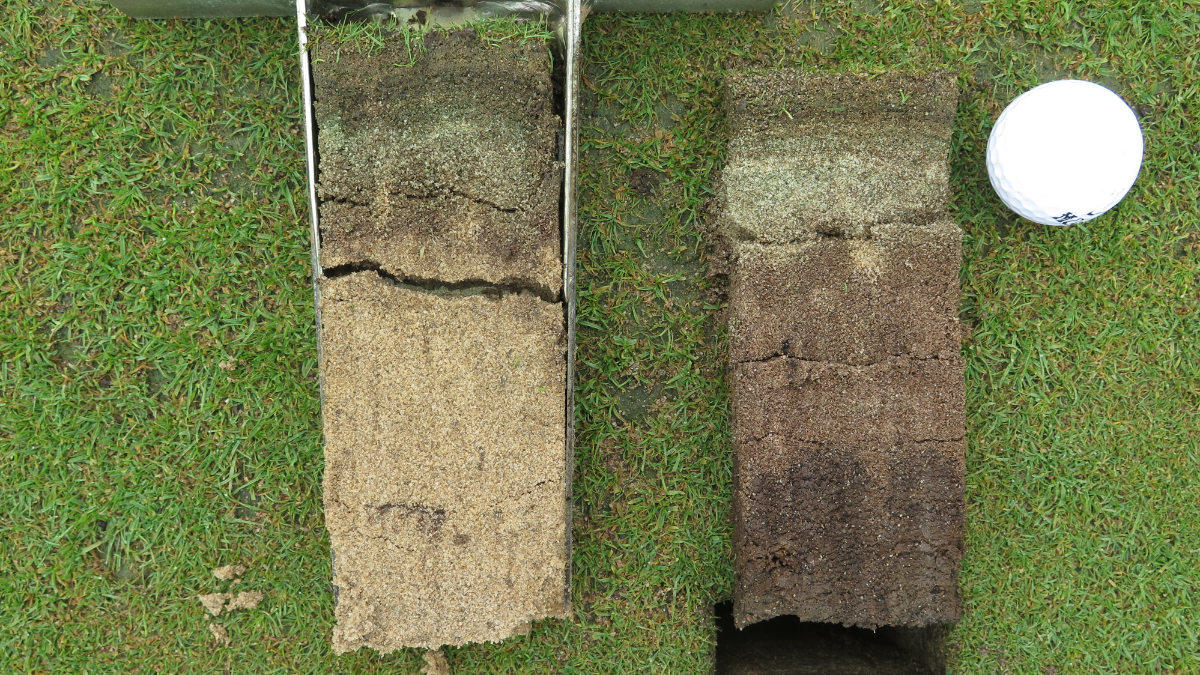
Summary
Organic matter management is one of the key components to providing healthy, resilient and firm putting greens. While there is no one‑size‑fits‑all programme, there are plenty of options to help greenkeepers accomplish what is necessary from an agronomic perspective while also trying to minimize the level of disruption to the playing surface. That said, the growing popularity of the methods discussed in this article does not mean that more traditional methods are not effective. Every course has its own site‑specific circumstances and the course manager should work with other managers at the facility to determine what programme is best for the golf course and golfers. Regardless of what methods are chosen, it is important to remember that the long‑term benefits far outweigh the short‑term disruption associated with any form of putting green cultivation.
Continue the conversation: Paul Jacobs is on Twitter at @Pauls_twiter
This article was first featured in the March 2021 edition of Greenkeeper International available for BIGGA members to read online here.
Where to look next...
Greentek
If the sight of a tractor and core plugger on your greens makes some of your members a little testy, there are also more discreet methods you can use in‑between times. The Thatch‑Away SUPA‑SYSTEM from GreenTek is long recognised as the premium brand of verticutting units. They are found on most golf courses and are compatible with all popular brands of greens triplex.
However, the really great bonus with these units is the way that the verticutting rotors can quickly be removed from the unit and replaced with a whole range of interchangeable cassettes. These include deep scarifiers, groomers, rotary brushes, and for aeration there are the Sarel Roller and Star Slitter cassettes. Sarel Rollers are a long‑proven method of spiking fine turf, to prevent surface sealing, and to enable air, water, and nutrients to penetrate the root zone. They leave the green peppered with thousands of neat round holes which also can be used as an ideal pre‑treatment before overseeding. For a similarly effective aeration treatment, but with an even more discreet effect on the surface, the Star Slitter cassettes are a further great tool for your armoury.
The beauty of using a greens triplex as your aeration power unit is not only its speed, manoeuvrability, and low ground pressure, but also that the members rarely even notice that you are using it to make holes in “their” beloved greens!
Contact GreenTek on 0113 267 7000 or visit www.greentek.uk.com for the name of your nearest dealer, and to book a free demonstration of these invaluable attachments.
Wiedenmann
Every buyer of a Wiedenmann Terra Spike receives bespoke instruction about how best to set it safely and optimally for local conditions. Almost always the installation training is given by one of the Wiedenmann team themselves, supported by a dealer representative.
This commitment to customer service began nearly 30 years ago, when Wiedenmann UK started trading, and it is still an integral part of the company’s sales package. Not unsurprisingly, the installation session emphasises all Health & Safety considerations that need to be respected; everything from making the working vicinity safe to learning the right way to couple and uncouple the Terra Spike. The Wiedenmann team member cuts the PTO shaft to suit the tractor/ machine combination, ensuring it doesn’t split on the longest point or bottom out at the shortest point, and, if required, they set the clutch on the PTO shaft. Next, comes a comprehensive run through of the correct procedures: the dos and don’ts associated with starting, stopping, appropriate revs, depth and heave settings and, of course, the required maintenance.
Course Manager, Tim Johnson, at Worsley GC, a parkland course, west of Manchester, took delivery of his GXi8 HD in October. He said: “This kind of H&S training session is hugely appreciated. Everyone is instantly knowledgeable, aware and confident. The machine can go into service from day one with everyone using it properly, and I know, we as a team, are doing our bit to maximise the lifespan and longevity.”
GKB
GKB Machines, the company behind sustainable, reliable and robust maintenance machinery for natural, synthetic and hybrid turf provide groundsmen with the solution to ground compaction thanks to their aeration products. With machinery including both the GKB Deep Tine Aerator (DTA) and the GKB Topair, groundsmen can confidently ensure their grounds are kept in prime condition.
With many turf professionals stuck between wanting their grass to grow but also wanting to maintain a levelled sports pitch, the GKB Topair offers the perfect solution. Thanks to its Evolvente blades, the GKB Topair minimises the surface disruption. The GKB Topair also reduces power usage by minimising friction between the blades and the pitch. Engineering with versatility, the robust GKB Topair features a hydraulically adjustable pressure roller, that allows users to aerate and level the sports pitch and/or execute these tasks separately.
Offering groundsmen with solutions to solve compaction by ensuring the layers of the field are intensively aerated whilst levelled, both the GKB Topair and GKB Deep Tine Aerator (DTA) work to provide greenkeepers with machinery to achieve their goals. Considered one of the major causes of poor sward density, root development and waterlogging, the GKB DTA works on natural sports pitches to relieve the surface compaction enabling water to travel through and for stronger roots to develop.
A unique feature of the GKB DTA is the quick swap tines, this feature allows you to swap the whole tine holder giving you the correct tines for your application in minutes. This innovative machine requires minimal maintenance as it’s fitted with heavy‑duty sealed bearings on the crankshaft, ensuring focus is always on improving the ground and less on maintaining the machine.
For more on GKB Machines and their reliable and robust range of machinery for natural, hybrid and synthetic turf, please visit www.gkbmachines.com or contact Tom Shinkins on 07495883617.
Toro
For exceptional aeration, the long‑standing favourite of golf courses and fine turf applications is none other than the Toro ProCore 648. With renowned Toro innovation at its core, the ProCore 648 has been designed with the customer in mind. Years of research, customer input, testing and attention to detail went into making the ProCore 648 the most efficient, productive and clean walking aerator on the market.
Its 48‑inch aerating width is one of the largest in the industry, and the location of its wheels in front of the aeration head, well out of the way of the coring path, means the machine doesn’t drive over the fresh holes, or run over the pulled cores from the previous pass, making clear‑up far cleaner, easier, quicker and less labour intensive.
The TrueCore ground‑following system maintains consistent aeration depth while six precision‑balanced coring heads make aerating remarkably smooth. With these innovative features, the ProCore 648 delivers minimum disturbance to the turf and gets surfaces back into play quickly. Plus, with the ability to aerate up to 18 greens in approximately seven hours, you can rest assured that the ProCore 648 is built to get the job done.
As one of the most time‑effective and clean pedestrian aerators on the market, it’s no wonder the ProCore 648 is the first choice for so many UK greenkeepers. For further information on the ProCore 648 or the range of Toro aerators, visit reesinkturfcare.co.uk, call 01480 226800 or email [email protected].
Campey Turf Care Systems
Having an effective aeration programme for 45 holes means taking advantage of small windows of time, and at Knotty Hill Golf Centre that is done using four Imants Shockwaves from Campey Turf Care Systems.
Two large 275 models are joined by a 220 and 210 which is used for the greens and tees. Having these reliable large machines is a crucial aspect of course maintenance at Knotty Hill with Owner and Proprietor, Ashley Craggs, working on the 600‑acre site alongside his dad, Denis, one full‑time member of staff and two seasonal workers.
The decision to operate with a small staff and large equipment puts an emphasis on taking advantage of limited time scales, and with the fleet of ShockWaves the course is draining better than ever.
“We close every Monday, and we use that time to aerate nine holes,” Ashley explains. “We only get that small opportunity, and if you don’t use it, then you’ve missed the boat. You’ve got to take advantage when the ground conditions are right, and that’s what makes the size and productivity of these machines so important to us.
“I know when those machines go to work, I won’t see them until they come back in at the end of the night. They are bombproof – when those machines go out, they’re moving, and they aren’t stopping. If they leave the yard at 8am they will run all day until 8pm.
“The best feature of the machines is the hydraulic depth control on the rear. Some of our land is clay, and then we’ve got good topsoil and then into sandy gravel – half of our site is sand and gravel. When you’re working on that, it’s harder because you can’t get the depth because it’s hitting rock.
“On some of our fairways one end starts with loamy clay and then goes into lovely topsoil, and by the time you get down the other end of the par‑five, it could be pure sand. So, when you’re driving the machine, you can adjust the depth from the seat to go full depth on the clay, but you know you can’t do that at the other end, so you pull the spool leaver and raise it three or four inches, and you’re doing the same neat and tidy job. There’s no stopping and getting spanners out, and that makes a big difference.
“We’ve noticed how well it’s draining and finding the lateral drainage systems that we’ve put in, so we found that the course drains quicker than it ever used to. If we get a down‑pour of rain on a Saturday night, we can still play golf on the Sunday, and that’s the key factor.”
The Golf Centre has gone from strength to strength since the farmland owned by Ashley’s dad, Denis, was converted into a golf course in 1991, with the popular site hosting 27‑holes of football golf and various practice facilities.
Redexim
A year on from its launch, the Verti‑Drain 2519 has proven its credentials as the ‘next generation’ of Redexim’s iconic Verti‑Drain range. Thanks to its 1.9m working width and ability to accept a range of tine options, the 2519 gives turf managers a high‑productivity aerator, with the versatility required for year‑round operation.
The 2519 model incorporates the very best of Redexim precision design and engineering. Together with a new draw‑rod system, it features an easy to adjust heave lever and slip clutch PTO drive ‑ offering a PTO speed of up to 540rpm which allows it to cover up to 8739sq.m per hour when spaced at 165mm. As standard, the Verti‑Drain 2519 comes with 12mm solid tines but it can accept a range of solid tine options up to 19mm, and hollow tines for coring. This versatility, combined with a variable working depth of up to 250mm, makes it suitable for an array of end‑users, across the full spectrum of the maintenance calendar.
Phill Hughes, Sales & Hire Director at Lister Wilder, explains that adding the 2519 to their hire fleet was an easy decision. “Our customers had long been looking for a solution for high‑speed aeration, particularly for fairways and sports pitches. The 2519 enables the operator to get the job done in less time, keeping disruption to a minimum and ensuring that play is returned quicker than before. It’s proven to be a huge hit with our existing customers as well as bringing new customers to us and has been especially popular during lock‑down as clubs prepare to re‑open ready for the busy season ahead.”
Author

